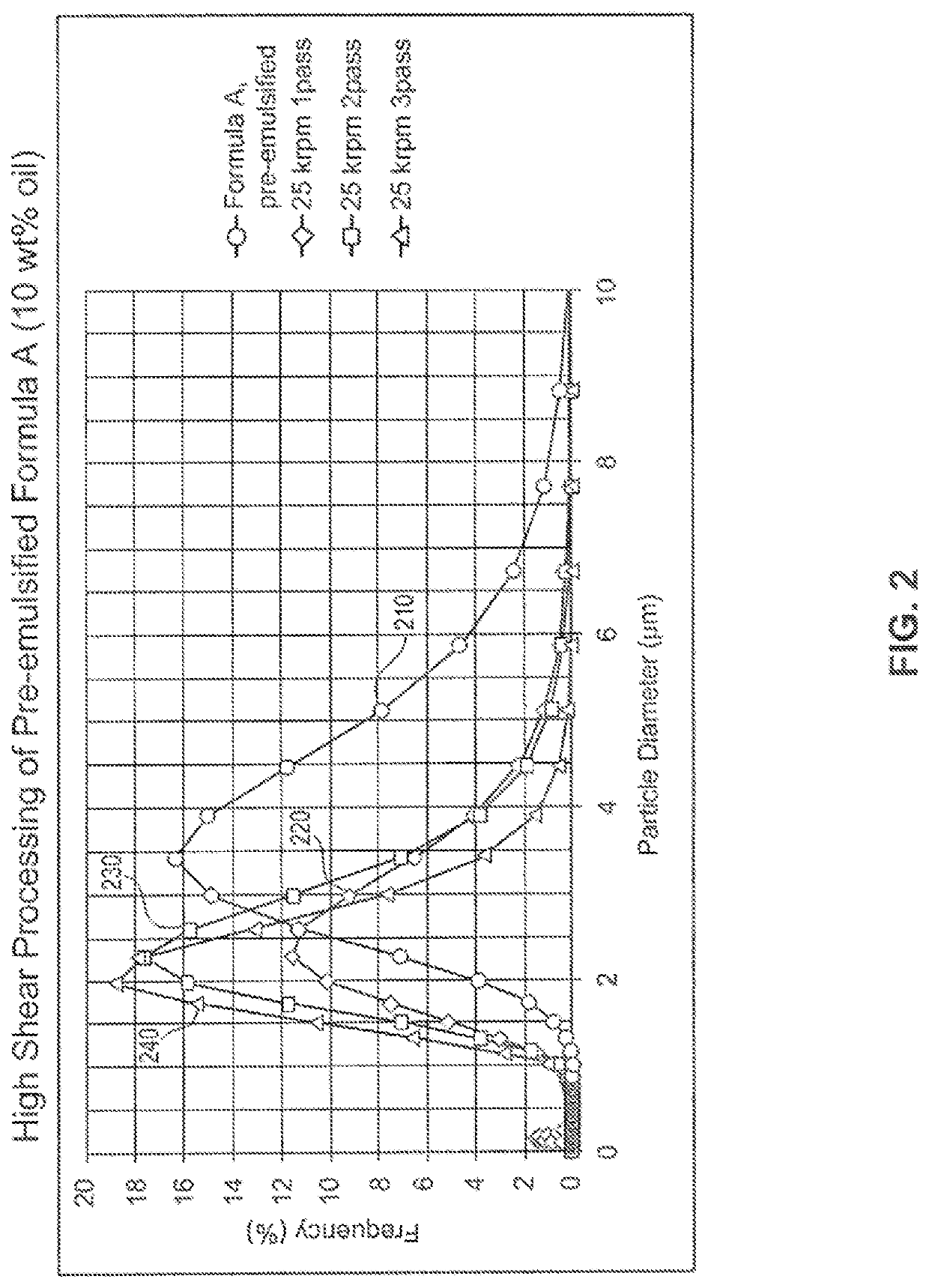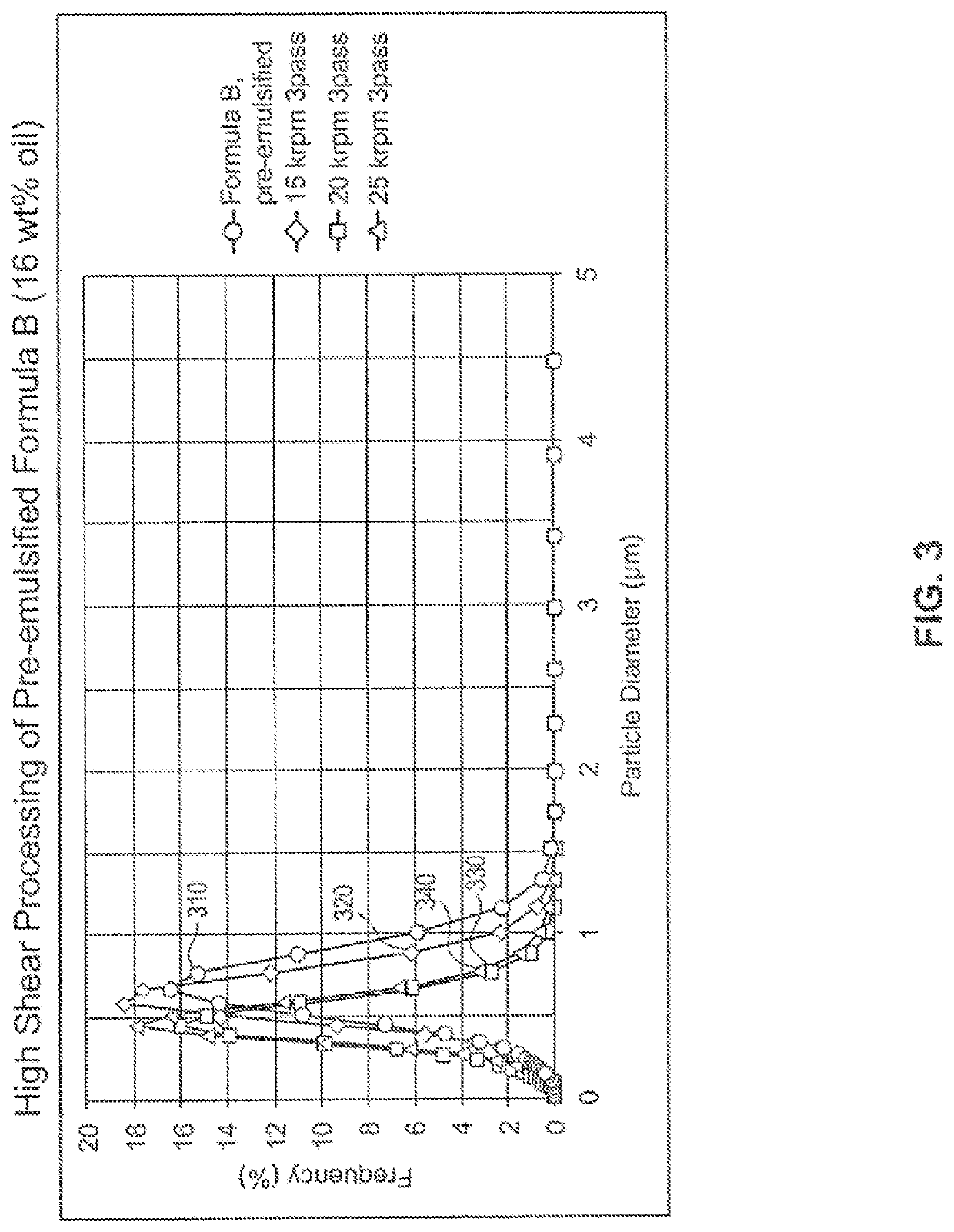Beverage nanoemulstions produced by high shear processing
a technology of high shear processing and beverage nanoemulsion, which is applied in the direction of dispersed delivery, plant/algae/fungi/lichens ingredients, and emulsifiers. it can solve the problems of high pressure homogenizers that cannot handle concentrated concentration, time-consuming and energy-consuming two-step processes, and inability to produce viscous emulsions with less water. it reduces the batch cycle time and achieves high shear mixing
- Summary
- Abstract
- Description
- Claims
- Application Information
AI Technical Summary
Benefits of technology
Problems solved by technology
Method used
Image
Examples
example 1
A-C
[0063]Three types of formulas were used as shown Table 1. Formula A is the standard formulation with 10 wt % coconut oil. Formulas B and C were more concentrated than formula A, providing 38% and 50% volume reduction, respectively. Formulas A-C were obtained by mixing the specified amount of coconut oil, modified food starch, sodium benzoate, citric acid, and water.
[0064]
TABLE 1Compositions of three formulas usedfor preparing beverage nanoemulsions.Formula AFormula BFormula C(wt %)(wt %)(wt %)Coconut oil1016.120Modified food starch1422.528(EmCap ®)Sodium benzoate0.10.160.2Citric acid0.150.240.3Treated water75.756151.5
[0065]Formulas A-C have different viscosities. Formulas B and C were more viscous than formula A (FIG. 1 and Table 2). Formula C cannot be processed through the high pressure homogenizer due to its high viscosity. Anton Paar RheoQC Rheometer with concentric cylinder (CC27) measuring Cup and corresponding Spindle was used to measure viscosity versus shear rate profile...
example 2
r Processing of Pre-Emulsified Mixture
[0067]Formulas A-C were pre-emulsified in a pre-mixing vessel equipped with a turbine agitator operated at 150 RPM, at 25° C. for 30 minutes.
[0068]The pre-emulsified mixtures were then processed in a high shear rotor stator mixer, and the results were shown in FIGS. 2-4. The shear range for the rotor stator mixer case is as follows: 300000 s−1 for 25 k RPM, 240,000 s−1 for 20 k RPM and 180,000 s−1 for 15 k RPM.
[0069]Pre-emulsified formula A (10 wt % oil) had d95 of greater than 7 μm, as illustrated by curve 210 in FIG. 2. Pre-emulsified formula A was processed with a high shear rotor stator mixer with shear rates of up to 300,000 s−1 (25 k RPM) for 5 minutes, in a recirculation mode for up to 3 passes. Curves 220, 230, and 240 in FIG. 2 show that the particle size (d95) of the resultant emulsions after one, two, and three passes is 5.0, 4.1, and 3.1 μm, respectively.
[0070]Pre-emulsified formula B (16 wt % oil) had a particle size (d95) of greate...
example 3
r Processing of Non-Pre-Emulsified Mixture
[0072]Formula C (20 wt % oil) was processed in a rotor stator high shear mixer at 25° C.-40° C. temperature for 5 minutes with a shear rate ranging from 180,000 s−1 (15 k RPM) to 300,000 s−1 (25 k RPM) for 5 minutes, in a recirculation mode for up to 3 passes.
[0073]The results were shown In FIG. 5. Curves 520, 530, and 540 in FIG. 5 show that the particle size (d95) of the resultant emulsions after three passes of high shear processing with 15 k, 20 k, and 25 k RPM is 0.69, 0.63, and 0.57 μm, respectively.
PUM
 Login to View More
Login to View More Abstract
Description
Claims
Application Information
 Login to View More
Login to View More - R&D
- Intellectual Property
- Life Sciences
- Materials
- Tech Scout
- Unparalleled Data Quality
- Higher Quality Content
- 60% Fewer Hallucinations
Browse by: Latest US Patents, China's latest patents, Technical Efficacy Thesaurus, Application Domain, Technology Topic, Popular Technical Reports.
© 2025 PatSnap. All rights reserved.Legal|Privacy policy|Modern Slavery Act Transparency Statement|Sitemap|About US| Contact US: help@patsnap.com



